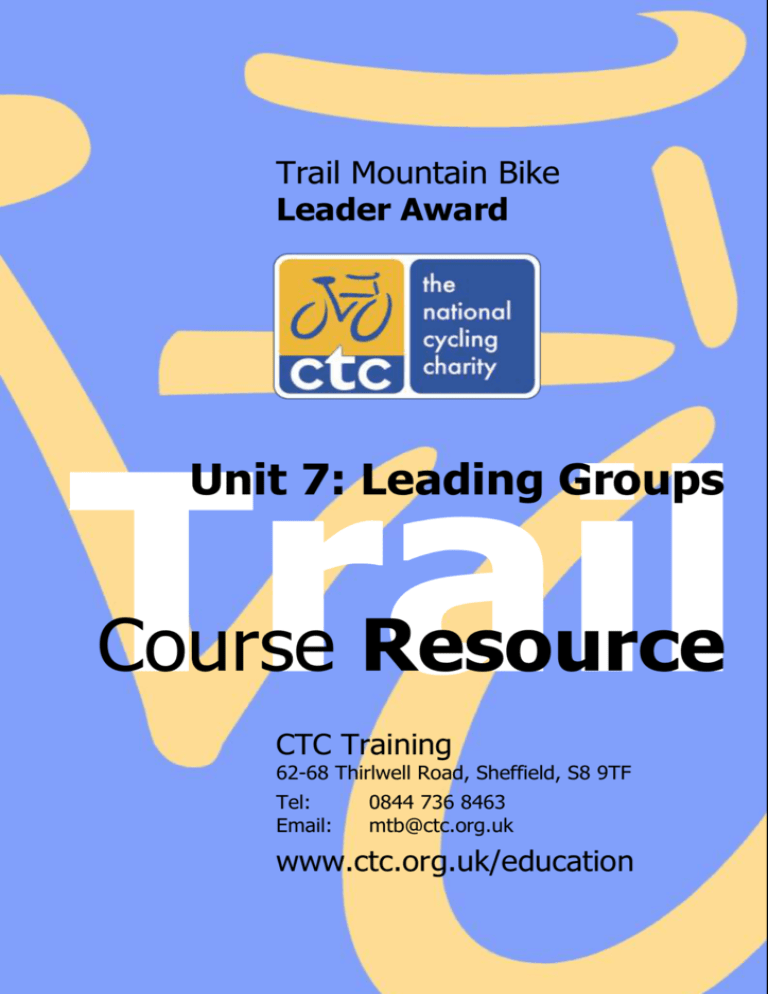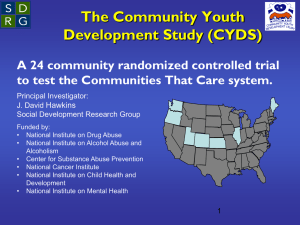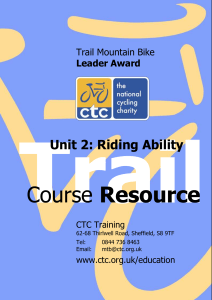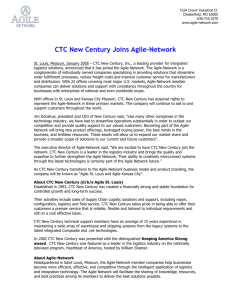
Trail Mountain Bike
Leader Award
Leader & Instructor
Awards
Trail
Unit 7: Leading Groups
Course Resource
CTC Training
62-68 Thirlwell Road, Sheffield, S8 9TF
Tel:
Email:
0844 736 8463
mtb@ctc.org.uk
www.ctc.org.uk/education
TRAIL MOUNTAIN BIKE LEADER AWARD
Leader Resource - Leading Groups
Contents
Title
Link
Page
Introduction
Go there
3
CTC
Go there
3
Section 3 – Best Practice Guide
Go there
4
Unit 7 – Leading Groups
Go there
5
Leader Position
Go there
6
Risk Benefit Analysis
Go there
8
Stopping Points
Go there
9
Communication
Go there
11
Other Leading Factors
Go there
12
Leading on Roads
Go there
12
Road crossings
Go there
13
Modifying Rides
Go there
14
Contacting CTC
Go there
15
© Copyright CTC 1996-2013
All rights reserved. No part of this publication may be reproduced in any form or by any
means without permission from the publishers.
To ensure that maintenance of appropriate and high standards of the Awards, CTC reserves
the right to alter any course specification or detail without notice.
© Copyright CTC 2012 – 13
Page 2 of 15
TRAIL MOUNTAIN BIKE LEADER AWARD
Leader Resource - Leading Groups
Unit 7 – Leading Groups
Welcome to your Trail Mountain Bike Leader Resource. This resource is designed to aid your
role as an excellent CTC mountain bike leader now and in the future. You should find that
you need to refer to it regularly even when leading often, as its content is entirely applicable
to your circumstances.
This resource is made up of several individual sections, which this is a section of part 3:
1.
Information on the Trail Mountain Bike Leader Award, how this fits within the National
Mountain Bike Leader Award Scheme and the National Mountain Bike Skill Awards.
CTC products and services and how these improve and enable the environment for all
cyclists and mountain biking.
Best practice information and principles for each section of the Trail Leader Award
Scheme. These sections are presented in the same unit order as the qualification
itself.
Your Logbook for the recording of future personal and leading rides that you
undertake, and ensuring your CPD is recorded
Pro-formas and exemplar forms for you to use in applying CTC’s best practice in
documenting your methods.
2.
3.
4.
5.
All sections are available separately as downloads from Trail Leader Resource page.
CTC
CTC, the national cycling charity administers and provides the National Mountain Bike Leader
Award Scheme as a National Governing Organisation. Its purposes in doing this are to
enable best practice in activity provision and accessibility to help engage millions of people in
mountain biking and cycling.
At CTC:
1.
2.
3.
4.
We protect cyclists
We inspire people to cycle
We promote cycling
We operate a highly effective organisation
CTC provide a wide range of services to assist Mountain Bike Leaders both in their role as
leaders and as individuals. More information about CTC is available in the CTC support and
services downloadable documents and at www.ctc.org.uk.
© Copyright CTC 2012 – 13
Page 3 of 15
TRAIL MOUNTAIN BIKE LEADER AWARD
Leader Resource - Leading Groups
Section 3 - Best Practice Guide
This section is made up of all the units that comprise the Trail Leader Award qualification
and is a guide to implementing best practice in these core areas. Each section covers all
aspects of how to plan and deliver led rides safely to a high level of competence. You should
refer to this section regularly as its content is of key importance to keeping you at the
appropriate standard for mountain bike leading. It can also be used as a tool to outline
essential aspects of mountain bike practice and safety to the individuals you are working
with.
Each unit covers a select area of importance with sub sections underlining the key points
that fall under that heading. The units are ordered as follows:
Unit
Title
Unit 1:
Ride preparation
Unit 2:
Riding ability
Unit 3:
Instruct others riding skills
Unit 4:
Trailside maintenance
Unit 5:
Navigation
Unit 6:
Pre-ride checks
Unit 7:
Leading groups
Unit 8:
Dealing with emergencies
Unit 9:
Environment
Unit 10:
Ending the ride
Each unit can be downloaded from the Trail Leader Award Resource page.
© Copyright CTC 2012 – 13
Page 4 of 15
TRAIL MOUNTAIN BIKE LEADER AWARD
Leader Resource - Leading Groups
Unit 7: Leading groups
Possibly surprisingly, being as the role and
qualification of a mountain bike leader includes
the word within the title, the leading of the groups
is only one section of many that you need to be
effective. The leading of groups is the one we all
want to do, and look forward to most. It is the
embodiment of taking people mountain biking and
the reason why we complete all the other areas of
our Leader role.
By the same token, it can be a fast moving,
dynamic and problematic environment where
things can go wrong very quickly.
To counter this; to help ensure that rides are safe
and enjoyable, Trail Leaders use some specific
techniques which you will have learned during
your CTC course. These essentially break down
into three key elements which can be adapted to
suit the context:
1. Leader position.
2. Stopping point.
3. Communication.
These are implemented as you see fit in your role as a qualified Trail Leader, but should
follow the guidelines outlined during your course, and as clarified over the following pages.
These three principles can be used to manage the group from the key perspective of
influences that hazards and motivation may have on them as a whole and as individuals
across a range of environments and circumstances.
Further these principles help to extend and maintain engagement in mountain biking with
participants whilst discreetly managing the safety elements we have to consider, identify and
pre-empt.
Classically, hazards for your participants might include (but not be limited to):
Trail obstruction, under tyre, overhead or to the side
Excessive speed
Other users (including other riders)
Traffic, towards, across or in the same direction.
Group separation
Themselves
Use (or incorrect use) of equipment
© Copyright CTC 2012 – 13
Page 5 of 15
TRAIL MOUNTAIN BIKE LEADER AWARD
Leader Resource - Leading Groups
Further, motivational factors can in themselves be considered hazards, at least to the
success of a ride, and therefore to the participants mountain biking experiences. Factors
which affect motivation are shown in table 1 below:
Reducing motivation
Increasing motivation
The ride being ‘too hard’
Success and achievement
Not being involved in the ride (e.g. when
one person keeps being asked to assist)
Being incorporated in roles and involvement
in managing the ride
Being cold, tired or hungry
Keeping energy levels topped up, remaining
warm and riding in the right conditions
The group being rigidly contained
throughout
Flexibility in where participants can ride
within the group; changes (swaps) in those
assisting.
Table 1: typical motivational factors in participants going mountain biking
Leader Position
To counter these, and manage the group
members through them in a discrete manner, one
of the key factors we use is Leader Position. This
technique enables you to be closer to the hazard
in advance of it, and requires that you are able to
anticipate its possibility. A key aspect of selecting
the correct Leader position is obviously therefore
knowing what is coming up over the next section
of the ride.
As you know, this can most
effectively (and sometimes only) be determined
by undertaking a pre-ride.
This principle also aids in prioritising your Leader Position in the event of two potential
hazards existing. For example, riding on a single track road has traffic approaching both
towards the front and rear of the group. Clearly, however, traffic approach is likely to be
most sudden at the front, helping you to prioritise the Leader Position. Should this be
influenced by other factors, such as a long and slow uphill, you may have to make a further
judgement based on riders’ needs and circumstances within the group.
© Copyright CTC 2012 – 13
Page 6 of 15
TRAIL MOUNTAIN BIKE LEADER AWARD
Leader Resource - Leading Groups
Tables 2 and 3 following, outline the context where Leader Position can help minimise
hazards.
Table 2:
Group management techniques – Leader position
Group
management
technique
Context
Downhill
Leader at front of
group
Leader at rear of
group
Hazard being prevented
Excessive speed
Approaching obstacle, road
junction, forestry workings,
other users likely or other
Late stopping
hazard that the participants may
not manage themselves
Single track road
Approaching vehicle
Varied participant fitness and/or
abilities
Preventing the dispersion / splitting
of group
Where the stopping point isn’t
obvious
Going the wrong way / too far /
encountering hazards
Uphill
Participants at back struggling;
group splitting; loss of motivation
Mechanical problem, either real,
or poor ability to use (e.g.
gears) by participants
Equipment damage; group
splitting; loss of motivation
Busy or narrow road
Traffic approaching from behind
As well as your own position, the use of an
assistant can greatly support your management of
the group and hazard minimisation. The context
and hazard prevention where assistants can help
is defined in Table 3 over.
© Copyright CTC 2012 – 13
Page 7 of 15
TRAIL MOUNTAIN BIKE LEADER AWARD
Leader Resource - Leading Groups
Table 3:
Group management techniques – Assistant position
Group
management
technique
Use of Assistants
overall
Context
Hazard being prevented
Using a variety of participants as
assistants
Loss of motivation through
involvement in the ride
Use of able adult assistant in the
roles as per the Leader position
above (usually at the opposite
end of the group to the Leader)
Managing the group as per the
hazards for Leader at the front
and Leader at the rear
Approaching hazards
Encountering hazard (assistant
can identify and manage or stop
group)
Where the stopping point isn’t
obvious
Going the wrong way / too far /
encountering hazards
Assistant* at front
Quick evaluations that all the
Group splitting; participant
group are together (the assistant
stopping for any reason
must stop with the participant)
* Assistant can be an adult assistant, or one of the participants. Where the assistant is
capable of making appropriate decisions, they can help fulfil the roles of the Leader at the
front or rear of the group
Assistant* at rear
Risk benefit analysis
It is now widely acknowledged within the Outdoors Education sector that it is vital for people
to encounter circumstances that help them evaluate and make decisions about risk. Only by
encountering risks are people able to evaluate further risk encounters. As for any learning,
balancing the level of risk to the capacity of the individual is critical to effective learning and
engagement, and this is part of your role as an effective Leader.
We must see encountering (some) risk as a benefit to personal development. As leaders it is
a core function to practically use and manage. Our role is to tangibility assess perceptive risk
and enable exposure to this risk resulting in positive personal development.
As well as using Leader Position, implementing effective Stopping Points and Communication
techniques aid this process, making it more manageable, consistent, flexible and adaptable
to the needs of your participants.
© Copyright CTC 2012 – 13
Page 8 of 15
TRAIL MOUNTAIN BIKE LEADER AWARD
Leader Resource - Leading Groups
Stopping points
The very nature of mountain biking means that
people ride at different speeds according to their
fitness, skill and desires. It is therefore necessary
to stop at regular points to regroup. However, the
use of stopping points also fulfils several other
functions:
Rest points for riders to recover
Provision of briefing opportunity for the
next section of the ride
Regular drink and small bite opportunities
Ensuring the group remains together throughout
Educational or developmental opportunity, such as skills technique, navigation, local
history or other focused session.
Stopping points are critical prior to where the group may encounter a hazard. This is
therefore affected by group members experience and what is a hazard to them. Adults may
be able to make successful decisions about contexts that children or young people might not.
Bearing this in mind, combined with the fitness,
skills and abilities of the participants to ride at a
similar speed will change the length of sections
between stopping points. A group of comparable
levels may be able to cover longer distances
between stopping points in comparison to a
diverse group. By example, where a group are all
together and the reason for stopping is minor
(e.g. a direction choice), as long as the group
members know the next stopping point, the group
can continue.
What makes a good stopping point?
Stopping points should be:
1. Safe;
2. Quiet;
3. Obvious.
Within safe, the stopping point needs to be
sufficiently large to contain the group; have
minimal impact on other people; be away from
passing cars, bikes and walkers or other activity.
© Copyright CTC 2012 – 13
Page 9 of 15
TRAIL MOUNTAIN BIKE LEADER AWARD
Leader Resource - Leading Groups
The quiet element requires that any briefing to the group for the next section can be heard
and understood, whilst most importantly be concentrated on (or listened to) due to
eliminating or limiting the distractions.
The obvious factor is crucial wherever you
request another person to be at the front of the
group, they can clearly see the stopping point as
they approach it. This is one of the most
important elements that you can resolve through
your pre-ride check, as the indicators someone
actually sees on the ground are highly likely to not
be shown on a map. Where the stopping point is
marginally vague, you can use a catch feature,
which the person at the front and the rest of the
group can clearly identify.
It is always appropriate to use stopping points where a change of track surface or context
(e.g. descent after a climb; quiet path to busy track; off-road to road etc) is encountered.
Classic stopping points and catch features might include:
Stopping point
Catch feature
Top of the hill
Start to descend
Track junction
Next section of track,
particularly a description of
the wrong one, if different
Distinct change of
environment e.g. entering
a wood
New environment, e.g.
open land, woodland,
change of track surface
Gate
Whether the gate is open
or closed
Just prior (50m-200m)to a
busy road junction
You, as the leader, will
reach this point first
© Copyright CTC 2012 – 13
Additional environments
where the catch feature
is pertinent
Vague hill top (i.e. gradually
rounded)
Where new skills may be
required or other users may be
encountered
Approaching other noisy
environments such as forestry
workings
Page 10 of 15
TRAIL MOUNTAIN BIKE LEADER AWARD
Leader Resource - Leading Groups
Communication
For a ride to be effective, your use of
communication
is
critical.
Communication
essentially comprises four elements:
1. What you say (the words you use);
2. How you say it (what you emphasise and
your tone);
3. Your non-verbal cues (body language,
gesticulation);
4. Enabling others to contribute (providing
opportunity, listening, reinforcement)
The use of these elements significantly influences how successful your group will be in
understanding and therefore implementing what you actually desire. Much of how you use
these factors will be influenced by both your own characteristics and those of the group.
Within the group management context, communication is vital throughout the session, but
will generally be defined with:
Defining boundaries (throughout the session, but especially at the start).
Being consistent and open.
Building learning opportunities (starting with the achievable and developing).
Repetition to reinforce.
Asking questions to ensure understanding.
Being positive about the environment, context and participants’ contributions.
Crucially within these, group specific factors will also include:
Using an appropriate number of key
points. This is likely to be reduced to three
for most groups (e.g. section surface,
hazard and stopping point) and could be
down to one for some sections and group
types (e.g. hazard where you are leading).
Keep this number low to match the
groups’ capacities.
Emphasis on these points being the first
and last things that are said at a stopping
point. (You might even try to do a
complete stopping point in less than ten
words!)
© Copyright CTC 2012 – 13
Page 11 of 15
TRAIL MOUNTAIN BIKE LEADER AWARD
Leader Resource - Leading Groups
Other leading factors
There are a handful of additional specific factors you should remember from your CTC Trail
Leader course and use as fundamental principles throughout your leading career. These
comprise:
Leading on roads;
Road crossings;
Modifications to the ride.
Leading on roads
Taking each of these in turn, when using roads
remember to:
Avoid using busy roads whenever possible.
Keep the group in one unit, according to
the capacity of the group members. This
has less impact on traffic and is also
evidence of the adage ‘safety in numbers’.
Remain in single file where the group have
limited riding experience or where the road
is narrow (a legal requirement on single
track roads).
Use paired up (two abreast) riding where
the group are capable and the road is
sufficiently wide. This is particularly
effective in slower moving traffic such as
urban environments and has the advantage that traffic can overtake more quickly as
the group is shorter overall.
Position yourself on the outside at the back of the group (or put your assistant there
if you need to be at the front). This creates a larger impact to the traffic behind and
helps to ensure the safety of your group. You are also best placed to gain eye
contact with any driver behind from here.
It is often useful to think of your group as a single vehicle, especially in an urban
environment or at junctions. Participants need to move as part of a unit rather than
making their own decisions for themselves.
Look directly at drivers. Eye contact is the most effective way of communicating with
drivers and is usually sufficient to indicate your right as a road user to be there, and
the nature of your group.
© Copyright CTC 2012 – 13
Page 12 of 15
TRAIL MOUNTAIN BIKE LEADER AWARD
Leader Resource - Leading Groups
Road crossings
Assuming that participants have a high level of
road awareness, are able to act as a group, and
have the capacity to set off quickly, then riding
across a road at an opportune moment is fine.
However, this is often not the case, and where
any of these three elements is not evident it is
appropriate to strip the road crossing back to
basics and identify control elements over it. It
need not be a patronising situation for
participants if you explain what is going on, why
and provide roles to members to aid the crossing
itself.
The time window
To cross a road safely means you need to be in a
location that provides sufficient notice of vehicle
arrival (i.e. you should be able to cross in less
time than an appearing car reaches you – the
time window). You can extend the time window if
necessary by:
Moving to a clearer location
Using listening skills as well as vision (only
possible when in a quiet location).
Using a group member to extend your
vision based time window (by them
moving down to a corner for example).
Note that in this situation, they should cross at the same time as you to ensure their
safety too.
You can also reduce the time window by:
Setting the group so they all set off at the
same time – they are listening and
attentive.
Getting the group to walk, pushing their
bikes (with less experienced riders, this is
quicker and reduces the likelihood of
collisions between participants).
Define what happens on reaching the
opposite side of the road – where do they
stand, which direction are they going to
travel in, that they wait before setting off.
Setting the group out in a line, so they all
cross together. Absolutely avoid the ‘lollipop lady’ style of one following the other as
this extends the time window enormously.
© Copyright CTC 2012 – 13
Page 13 of 15
TRAIL MOUNTAIN BIKE LEADER AWARD
Leader Resource - Leading Groups
Where space is limited, split the participants into two or three smaller groups, all
under your direction.
Modifications to the ride
It is very difficult to define how long a ride may take. Factors such as weather, group
capacities, ground conditions and mechanicals all change the speed at which a ride runs as
well as how it might operate, and therefore the finish time.
There are several techniques to extend the ride
time; very few to reduce it! It is always best to
err on the side of caution as additional time can
be filled with:
An additional loop, or route extension.
These are usually called contingencies.
Additional riding skills development
Other skills development (other associated
skill – navigation, puncture mending etc)
Games
Route
Contingency 1
Reducing the time of a ride can only happen by:
Riding faster (unlikely in most cases)
Reducing the ride distance – modify the
route accordingly with a contingency you
have planned in.
Contingency 2
Changes to the route itself are fundamental to the
route planning role, and it may be the group isn’t
even aware that the route has been modified (a
very positive situation). Of course, you should
have always pre-ridden your contingencies too!
© Copyright CTC 2012 – 13
Page 14 of 15
TRAIL MOUNTAIN BIKE LEADER AWARD
Leader Resource - Leading Groups
Contacting CTC
You can contact CTC’s various departments as below:
CTC National Office
CTC Education
General enquiries; Holidays; Finances;
Campaigns; Commercial; National
strategies; Course booking
National Mountain Bike Award Scheme;
Courses; Qualifications; Technical support
CTC
Parklands
Railton Road
Guildford
GU2 9JX
CTC Education
62-68 Thirlwell Road
Sheffield
S8 9TF
Tel:
0844 736 8450
Email: cycling@ctc.org.uk
Web: www.ctc.org.uk
Tel:
0844 736 8463
Email: mtb@ctc.org.uk
Web: www.ctc.org.uk/education
All photos and content © Copyright CTC 2012-13. E&OE.
© Copyright CTC 2012 – 13
Page 15 of 15







